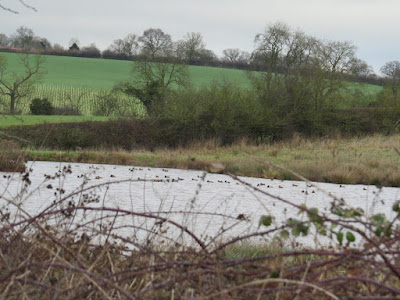It has been a difficult week. On Wednesday I was hard at work in Birmingham city centre unaware that the first live Razorbill in the West Midlands since 1917 was swimming around Draycote Water. I should have checked the Internet at lunchtime but didn't get around to it, so the first I knew of it was from a phone call from Mike during the evening.
Thursday dawned, and the news was initially "no sign of it", later firmed up as "Razorbill found dead". Meanwhile we were hosting a young man from Virgin who was converting us to their bundle of products. The internet and television went fine, and he told us he had switched the land line from BT but that the phone wouldn't work for a few hours. I signed his piece of paper, but then as he was leaving he said "don't forget to plug it in". Strange. "Where do I do that? ""Oh you can't until you get a telephone micro-filter" he said. "You can buy them in Tescos". He left at speed. I headed for Tescos and bought an ASD filter, which the electrics expert there thought the engineer probably meant.
24 hours later the land line still doesn't work. Don't bother trying to phone me.
So this morning I felt I needed some birding to soothe my frazzled nerves. I headed for Morton Bagot on a fine and sunny morning. I took my time, looking in every bush and tree, but could only find the usual stuff. A pair of Stonechats posed rather well.
 |
| Male Stonechat |
 |
| Female Stonechat |
The Flash field contained three Green Sandpipers, five Snipe, 18 Teal, and a Black-headed Gull. Very few birds were moving and until I saw a distant party of 20 or so presumed Redwings, I was finding there were more Song Thrushes than Redwings in the hedgerows.
At this point I got a phone call from Mike. Chis Lane had found a Yellow-browed Warbler at Broom, just ten miles away. I abandoned the Flash field and headed straight for Broom, where I found Mike and Jean conversing with Chris. The news was not encouraging. After seeing the bird twice Chris had lost it while sending texts. It hadn't reappeared. After about 15 minutes I had seen a Kingfisher and a party of tits which briefly raised the optimism levels, but failed to contain any warblers. Mike and Jean decided to go to the pub, but I declined their invitation to join them.
Two hours passed, during which time I received a text from Matt W saying that he had seen a Barn Owl over the flash field at Morton Bagot about an hour after I had left. Chris and I managed to see a Goldcrest.
Like I said, it's not been a good week.
Post-script: Shortly after posting the above tale I thought I would nip back for an hour on the patch this evening. Slightly to my surprise this was completely successful as I flushed the Barn Owl out of trees bordering the flash field, and was then able to get a distant record shot.
 |
| Barn Owl |
The rest of the stroll round added a Kingfisher and a Marsh Tit to this morning's tally. I also took a photo of a white-chested Buzzard as dusk approached.
If you are thinking it looks a bit long-tailed, the thought had occurred to me too. Unfortunately it disappeared shortly after this shot. Also, I think I have seen this individual before this autumn, and if so, it is just a Common Buzzard.

















































